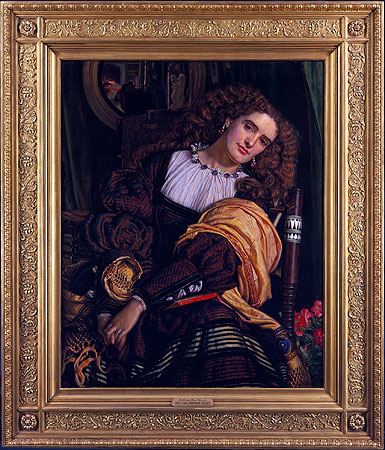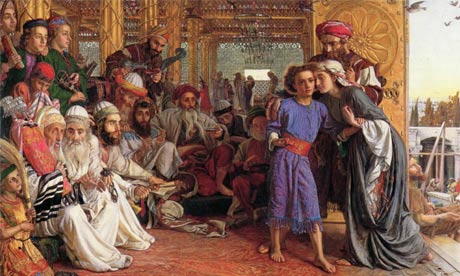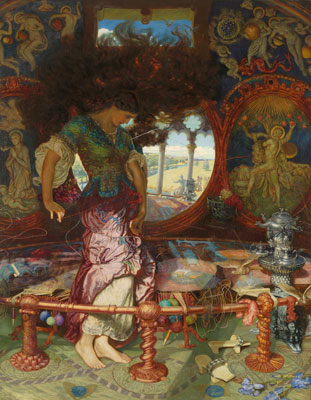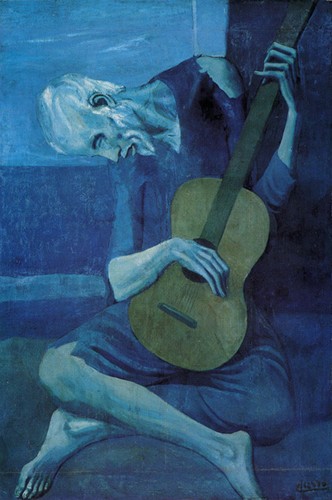 He's late. She leans back in her chair, stares into the fire, watching the quiet dance of its flames. The book at her knee is forgotten. Her mind wanders, imagining what it would be like to live like this, winter evenings spent at home, the soft certainty of domestic peace.
He's late. She leans back in her chair, stares into the fire, watching the quiet dance of its flames. The book at her knee is forgotten. Her mind wanders, imagining what it would be like to live like this, winter evenings spent at home, the soft certainty of domestic peace.Lost in the daydream, her face is beautiful, the guilelessness of its repose belying her jewels and her dress. The glow of the fire fills the room with a kind of contentment. It is a lovely scene, made even more lovely by the knowledge that any moment now he will arrive and the trance will be broken, the illusion dissolved.
The painting is William Holman Hunt's Il Dolce Far Niente from an exhibition of Hunt's work at the Minneapolis Institute of Art.
Now, personally, I've never been big on the Pre-Raphaelites. They're nice enough, I suppose, but their work always strikes me as a little stodgy and well, Victorian, lacking the weight of the old Masters, the passion of the Impressionists and the wit and inventiveness of modern art. Still, there's something charming about an exhibition that includes scenes from Keats (The Flight of Madeline and Porphyro) and Shakespeare (Claudio and Isabella) instead of the usual biblical fare [1]. And Hunt is an exquisite draftsman, with an eye for telling detail, and an ability to capture emotion, even if his pallette strikes me as a little garish [2].

These qualities are perhaps best seen in Hunt's Finding of the Savior at the Temple (above). The group of Elders at the left is done in a way that would make the Old Masters proud - combining near photographic realism with a richness of variety and detail - and the figure of Mary clasping her son perfectly conveys both relief and solicitude. The boy Christ is hypnotic: burning with self-confidence and inner strength he stands free of all around him, effortlessly dominating the scene; yet for all that he is an unidealised figure, a portrait of an innocent and beautiful, vaguely middle-eastern twelve year old. But what makes the painting for me is the figure of the beggar sitting just outside the door, the perfect counterpoint to the lavish interior of the temple and a depiction (along with the figures in the right background, putting together what looks like a white coffin) of the distance between the reality of human suffering and the power-hungriness of organized religion. Mary's gesture of drawing her son away is thus two-fold, both the act of a mother concerned for her son, and a reminder, perhaps, that the true savior's place is not among the priests, disputing matters of metaphysics, but among the suffering and the needy.
Glorious as this painting is, however, it is easily outshone by Hunt's Lady of Shalott (below), easily the finest work on display at the MIA exhibition. I've always associated Tennyson's poem with another painting of the Lady, one by Waterhouse [3], but having seen Hunt's version I'm tempted to transfer my loyalties.

What makes this painting so vivid is the sheer violence of the scene, the sense, so perfectly conveyed, of a room, no, a world being shattered. The mirror cracks, the doves take off in panic, the flowers fall to the floor and the Lady's hair explode into a torch of raging fire, as if her senses had been set aflame. The Lady herself is tangled in thread from the weaving, thread that she is tugging off her, so that the painting becomes, literally, the portrait of a woman coming undone. And when you get past the first impact there are other, subtler touches. Like the depiction of Hercules picking the golden apples, with its echo of the fate of Atalanta, another occasion when a moment's break in concentration led to a permanent fall. Or the figure of Lancelot, so distant, so perfectly unaware, riding away in the sunshine of his freedom, seen in a mirror that is at once a porthole and a crystal ball. And is it just me, or does the pallette here look forward to Klimt, and don't those electric squiggles of yarn remind you of Pollock? The Lady of Shalott is an explosive, visionary work, one that makes a strong case for Hunt as a painter [4], and that, by itself, makes the MIA exhibition worth a visit.
[1] I'm particularly fond of the latter painting, because of the way Hunt sets up the contrast between Claudio's flashiness and Isabella's sobriety, a contrast echoed in reverse by the lyre hanging behind her shoulder and the chains lying at his feet.
[2] One result of this is that in many cases I find that I prefer the etchings that reproduce Hunt's paintings - some of which are included in the exhibition - to the paintings themselves.
[3] I'm told that Waterhouse's connection to the Pre-Raphaelites is a somewhat tenuous one, but to me he's very much part of the genre, and arguably my favorite of the lot.
[4] The exhibition focuses mostly on Hunt's work, though a few paintings by others are included: a couple of Dante Gabriel Rossetti's (notable only for the fact that it's not everyday you find a painting accompanied by two technically perfect sonnets describing it) and Arthur Hughes' Long Engagement, which is like a portrait of how the Arnolfinis would have turned out if they'd been too poor to marry.




No comments:
Post a Comment